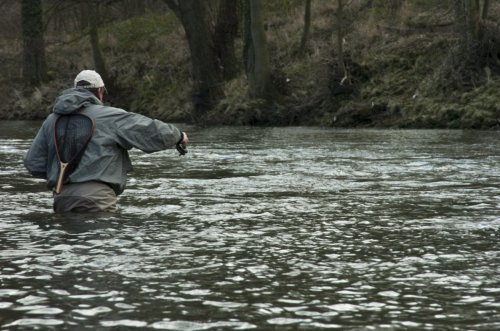The late afternoon light from the steely grey sky reflected over the dark water. The heavy rain had now eased into a fine mist as a Red Kite, now successfully re-introduced to the Yorkshire countryside, hovered and dipped over the meadows. The vantage point on the river bank gave me a clear view of a few trout, flanks flashing like blades amongst the loose stones on the river bed. I had finished my lunch and continued to watch the feeding trout whilst sipping my coffee. I knew that stoneflies where not as prolific during October and quietly pondered wether they where grubbing for caddis. I guessed that 6 or maybe 7 trout turned whilst finishing off my coffee. I dug deep into my pockets for a fly box that contained a few of my cased caddis patterns and nipped one onto my 6x tippet. My fly rod is a Hardy 10' 5wt Marksman and a 5wf floating line is loaded on my fly reel. Perfect coupled with a 7' tapered mono leader and 3' of 6x tippet. This outfit enables me to stretch out and get a good 15' reach, allowing me to stalk closer to the feeding trout.
I watched the trout feeding as I waded towards them through a knee high current. I decided that the best angle to cast from was up-stream at about 2 o'clock. The drizzle had now cleared as I made an easy swing with the heavy caddis pattern, pretty much like an underarm swing-With a light plop, the caddis pattern sank ahead of the feeding trout as I let out some line to allow a free drift down stream, like one would do with a down stream dry fly technique. The caddis fly drifted through the fish, so I lifted my rod tip and eased the line out to the side so as not to disturb them. I re-cast and again my caddis fly drifted perfectly downstream, tapping the riverbed as it went. Still nothing. I tried this another 4 or 5 times and pondered about using the 'Leadhead' technique that my fly fishing buddy, Hans van Klinken taught me on a beautiful Tuscan Italian stream.
Hans Leadhead technique takes a little getting used to as; rod tip and line control are essential, however, when one gets the rhythm right its very easy. Firstly dead drift the caddis pattern downstream like one would Polish style, let out some loose line when the caddis pattern is about 20' downstream and flick the rod tip up-stream making the caddis pattern jump up-stream on the river bed. Let out another arms length of line and repeat the up-stream flick of the rod tip. Gradually the caddis patterns jumps up-stream passing the feeding fish, which must either; really annoy them or it replicates a drifting or dislodged caddis. Either way, it's really effective.
It had been a year since my Tuscan lesson, so my first few casts were clumsy. Then, it all came together and bang, fish on. Out of that pod of fish I released four of them. 'Not bad for being a bit rusty'. Nothing huge but nice, fit brownies. Later that day as the light started to fade I also released a few ten-inch grayling before making my way back towards my wagon.
Tying tips
There are many hooks on the market similar to the Mustad. Look for a long slightly curved shape with a good gape. The pen top tip I still use to this day however, since then their have been many new products which can replace it. Such as, tungsten cone heads for one. Invert it when sliding it on the hook. This adds even more weight if it's needed. When using Nymph Skin, alter the tension as you wrap it to make a nice tapered grub head. I tend to use the translucent and colour it to match the hatch or use the bright caddis green Nymph Skin which is quite effective. When making the legs get a good quality golden pheasant centre tail and pluck out a fibre from the quill. The bit that was attached to the quill is used as the fore leg and tie in the fibre part. As you tighten the thread the leg will pop out away from the soft Nymph Skin making the legs very prominent. Making the case is very easy. "Very much a 'Blue Peter' technique". Make sure the flat fibered thread you have wrapped over the lead underbody is soaked really well with glue or varnish, either works. And, if you have a vice that rotates, turn it whilst sprinkling on the Virtual Nymph Caddis Coating. I like using this product because it is a heavy material and has a glassy sparkle to it which attracts the fish. Other coatings can be used in the same way. I have found a good range of colours and textures in model making shops. Or, collect some natural fine sand (see caddis picture) or fine twigs for really realistic effects. However, which ever way you decide to finish off these caddis patterns, try and learn Hans's technique, it's very effective and adds another skill factor to a fly fishers ability to enjoy another technique on a river somewhere…

















